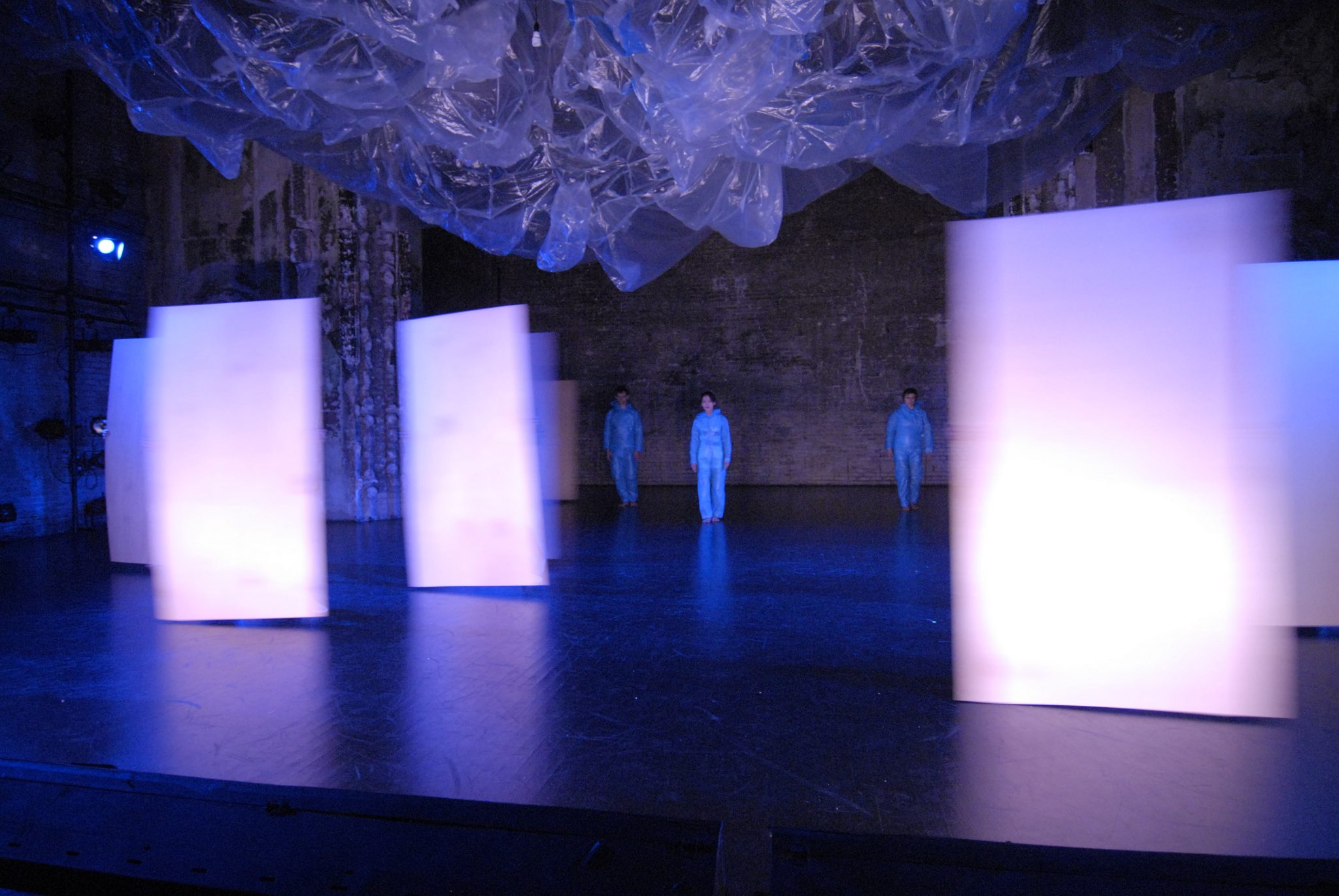Source: ARTCO MONTHLY No.212
author: Chia-Ling Lee
You can download the PDF from magazine here
Here is a translation from the original Taiwanese by Jesse Field
Of History /Of Nuclear Energy/Environmental Consciousness
The specialized term “half life” from radioactive physics originally refers to the course of nuclear reactions within the atom. The artists of the BodyCartography Project have appropriated it as the title of their new work. Half Life creates the artistic relationship between nuclear physics and the physical movement of the body, thus advancing the persistent inquiry into nuclear themes. This environmental concern is the pride of Bieringa’s mother culture – New Zealand is a nuclear-free zone. The 1/2 Life of 2002 was still a concept only just thought up from out of the spirit of some earlier scenes from dance/video works by the BodyCartography Project. Until, that is, a 2007 trip to Japan’s Kyoto Arts Center to do a three-month residency, in collaboration with dancers on the ground in Japan. Then they lanched 1/2 Life in its concrete form. The show conveys the tight connection between the invention of nuclear energy and the world of humankind in a stage of early modern history. Besides this research, the work is also a collaboration with physicist Bryce Beverlin II to get through to the scientific content of nuclear physics. Bieringa and Ramstad take this real-world data and materials and evolve it into movements for the body of the performer. Whether ensemble or solo performances, all scenes of 1/2 Life feature a shadow of the body, twisted by slowness or intensity. With three full years of research and planning to it, slow or intense and twisted certainly was a slow process of creation. This also reflects the view of American artist Hal Foster that “artists are like ethnographers.” Artists since the 1980s have used the language of art to deal with topics in society, culture, politics, education, and economics. This is very different from the belief of modern artists that “art is for art’s sake.” This direction of artistic creation makes the things that art deals with not limited by issues of formal materials; the content and trends within topics of investigative and observational research also become important processes for molding artistic expression.
Of Bodily Movement/The Direct Translation of Science
The experimental theater PerformanceSpace 122 was the location for the premiere of the BodyCartography Project’s new work 1/2 Life. The theater’s dark hall is made to bear an important, contemporary experiment in the “totality of art” conveyed in the sixty minutes of 1/2 Life. This includes sculpture and installation by visual artist Emmett Ramstad, body-movement performances by dancers Olive Bieringa, Otto Ramstad and Kitamura Takemi, as well as musical accompaniment by composer and harpist Zeena Perkins. Out of a visual display of molded plastic materials emerges a contemporary artistic ceremony that symbolizes the links between nuclear energy and ecological systems in contemporary art. Artist Emmett Ramstad’s use of so much plastic material applies a random, organic construction to put a ceiling over the experimental drama. Bieringa calls this a sea of plastic, meant to convey the nature of lines of invisible radiation and the irresolvable reality of plastic. The performers slowly come onstage, faces expressionless, bodies costumed in plastic. By turns they slow and then intense, moving their bodies in dance they enter the dark, box-like space of the theater. The performing ensemble usually hides their bodies behind thin wooden panels, as if using them as protective quarters. They move them constantly, but then in an instant the curved wooden panels become still and motionless, forming a scene of abstract “live sculpture.” At times the assisting performers holding the thin wooden panels sway them to create a live, natural sound. These “shadow movers” resemble the assistants to Japanese “kuroko” performers, who stand behind them, dressed in black. But they also symbolize the “critical mass” for chain reactions in nuclear physics, as well as the “group mind.” The performers are like the live plastic material in motion, with their physical movements directly translating the concepts of nuclear physics, including matter, energy, radiation, and resonance effects; their bodies here symbolize matter. In the last scene of the performance, a space constructed of wood and canvas slowly slides onto the stage. It looks like living quarters meant to hold shadows. The essence of the architectural elements is derived from Japanese metropolitan temporary canvas housing erected by vagrants. The performers, in this four-sided room, moving back and forth among the pleasing natural shadows cast on them, finally strip off all their clothes to present the movements of washing their bodies clean, concluding the performance of 1/2 Life.
The term “cross-disciplinary” which has spurred a flood of discussion for some time would seem appropriate to talk about the work 1/2 Life, which combines such multiple layers and forms of art as theater installation, body movements by the performers, and natural sound accompaniment. But to the BodyCartography Project, using the term “cross-disciplinary” to describe the work is not as good as speaking of their efforts to engage in “transdisciplinary” concepts. This is because “cross-disciplinary” refers to a dialogue between disciplines, while the Latin root “trans” in “transdisciplinary” has the meaning of “penetrating into,” “through,” which reflects the BodyCartography Project’s effort to completely unify different fields in one work. Many contemporary artists are using a “multiplicity” of art forms. These at once answer and also reflect the circumstances of the age we are facing. American art historian Meyer Schapiro has said, “Every change in ideology brings in a new style or a new art — every change in the content of art is produced by a specific social change, which is material in origin.” Perhaps Schapiro’s comment explains 1/2 Life with the concept of “transdisciplinary:” a various and multiple contemporary artistic vocabulary.


